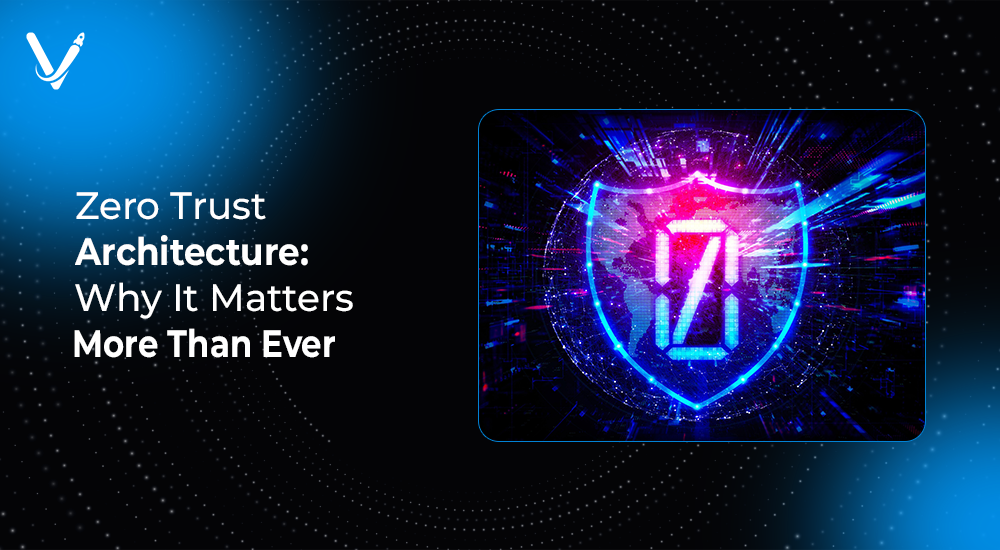Zero Trust Architecture: Why It Matters More Than Ever


- Jun 1, 2025
As organizations embrace digital-first operations, the traditional idea of securing a network perimeter has become outdated. With more employees working remotely, applications migrating to the cloud, and cyberattacks growing in sophistication, the need for a new cybersecurity approach is clear. This is where Zero Trust Architecture enters the scene. It redefines security by rejecting the notion of inherent trust and instead enforces continuous validation of every user and device. In this article, we explore what Zero Trust Architecture is, why it's crucial today, and how businesses can successfully adopt this model.
Zero Trust Architecture is not just a buzzword—it's a paradigm shift in how we think about security. Unlike legacy models that assumed everything inside the network was trustworthy, Zero Trust insists that no user or device should be trusted by default, no matter where they are. Instead, it mandates strict identity verification and continuous validation at every access point. Understanding the core principles of Zero Trust is essential before diving into its implementation.
Identity Verification
Every user, device, or application must authenticate itself through multi-factor authentication (MFA), biometrics, or certificate-based methods.
Least Privilege Access
Grant only the necessary permissions needed to perform a specific task—nothing more.
Microsegmentation
Break the network into smaller, isolated segments to contain breaches and reduce lateral movement.
Continuous Monitoring and Logging
Track user behavior and access patterns continuously to detect threats early.
Device Security Posture
Access is conditional based on device health, security compliance, and update status.
Cybersecurity threats today are more targeted, persistent, and damaging than ever before. From ransomware and insider threats to cloud misconfigurations and phishing attacks, businesses are under siege. Traditional defenses fail to keep pace with these evolving threats. That’s why Zero Trust has become a critical cybersecurity framework for organizations of all sizes. It offers a proactive, adaptive approach to safeguarding data in an increasingly complex digital environment.
The rise of remote work and BYOD (Bring Your Own Device) policies has blurred the boundaries of enterprise networks. Employees now access company resources using personal devices over untrusted networks, increasing the potential attack surface. Zero Trust mitigates these risks by requiring identity and device verification every time a user requests access.
Cloud-first strategies offer flexibility and cost savings—but they also introduce new threats. Traditional perimeter-based models fall short in cloud environments. Zero Trust adapts seamlessly to hybrid and multi-cloud architectures by enforcing access policies and validating identity continuously.
In 2024, cybercrime costs are expected to exceed $10.5 trillion globally. Phishing, ransomware, insider attacks, and advanced persistent threats (APTs) are more prevalent and damaging. Organizations with Zero Trust policies reduce breach risk, minimize damage, and respond faster to incidents.
Global regulatory frameworks—such as GDPR, HIPAA, and CMMC—require stronger security practices and data protection. Zero Trust principles align well with compliance goals, offering granular control and audit trails that demonstrate adherence to regulations.
Implementing Zero Trust is not about deploying a single solution—it's about building a strategy. This section breaks down the key components that form a comprehensive Zero Trust Architecture, including identity management, device posture, data encryption, network segmentation, and real-time monitoring.
IAM tools such as Okta, Azure AD, or Ping Identity authenticate users through multifactor checks and implement Role-Based Access Control (RBAC).
By dividing the network into smaller segments based on departments or functions, microsegmentation limits the blast radius of any breach. Tools like VMware NSX and Cisco ACI help enforce segmentation policies.
Solutions such as CrowdStrike and SentinelOne analyze endpoint behavior to identify anomalies. They can automatically quarantine infected devices or deny access to sensitive systems.
SIEM platforms like Splunk and LogRhythm consolidate logs from across the enterprise to detect threats and generate alerts in real-time.
SASE merges WAN and cloud security, delivering Zero Trust Network Access (ZTNA). This enables secure, policy-driven access to applications from anywhere.
Encrypting data in transit and at rest protects against theft. Data Loss Prevention (DLP) tools ensure sensitive information doesn’t leave the organization inappropriately.
Adopting Zero Trust isn’t just about preventing cyberattacks—it also brings measurable business value. Organizations that implement Zero Trust benefit from stronger security, reduced risk, better compliance, and improved operational efficiency.
Because ZTA continuously evaluates access requests, it's harder for attackers to move laterally within the network. Even if one endpoint is compromised, the threat is contained.
Zero Trust’s strict access controls and visibility features reduce the chances of insider attacks—whether malicious or accidental.
Security teams can gain full context of who accessed what, when, and how. This improves detection, response, and auditing capabilities.
As companies adopt new digital tools, Zero Trust ensures these innovations do not compromise security, thus enabling safe transformation.
By integrating real-time monitoring and automation, Zero Trust enables quicker detection and remediation of threats.
Despite its growing popularity, there are still several myths surrounding Zero Trust. Some believe it’s only for large enterprises, while others think it requires overhauling all infrastructure. This section dispels these misconceptions and clarifies what Zero Trust truly involves—making the case that it's practical and scalable for any organization.
Reality: Small and medium-sized businesses face similar cyber threats. Cloud-based Zero Trust solutions can be cost-effective and easier to deploy.
Reality: Firewalls still play a critical role in perimeter security, but Zero Trust enhances security through continuous verification and monitoring.
Reality: A phased implementation starting with high-risk areas makes Zero Trust manageable. Many organizations implement it one step at a time.
Transitioning to a Zero Trust model doesn’t happen overnight. It’s a phased journey that involves careful planning and execution. Here, we provide a step-by-step guide to help organizations begin their Zero Trust journey—from identifying critical assets to deploying microsegmentation and enforcing strong identity controls.
Identify what matters most—your crown jewels. These could be financial systems, intellectual property, customer data, or cloud infrastructure.
Understand how users interact with your protect surface. This visibility helps define who should have access and how data flows.
Use firewalls and access controls to isolate your protect surfaces. Apply granular rules for each segment.
Adopt strong authentication and authorization frameworks like MFA, single sign-on (SSO), and RBAC to validate user identities.
Check every device’s posture before granting access. Ensure patches, antivirus, and encryption policies are in place.
Monitor activity across networks, endpoints, and cloud environments. Feed insights into your SIEM or XDR to improve responses and fine-tune policies.
Theory is powerful, but real-world success stories are even more convincing. This section showcases how industry leaders like Google, the U.S. Department of Defense, and Capital One have successfully adopted Zero Trust principles to fortify their digital environments.
Google launched BeyondCorp, its internal Zero Trust initiative, to allow employees to work securely from any location without a traditional VPN. Every request is authenticated based on identity, location, and device.
The DoD’s Zero Trust strategy requires all branches and vendors to adopt ZTA by 2027. This shift ensures secure collaboration and information sharing in high-stakes defense operations.
After a damaging breach in 2019, Capital One implemented strong Zero Trust measures—segmenting data, monitoring access, and automating incident responses across its AWS infrastructure.
While the benefits of Zero Trust are clear, the journey isn’t without hurdles. Legacy systems, organizational silos, and tool sprawl can complicate implementation. This section outlines the most common challenges organizations face and offers guidance on how to overcome them strategically.
Older applications and systems may not support modern access control or monitoring. Wrappers, APIs, or microservices can help modernize them incrementally.
Implementing Zero Trust requires collaboration between IT, security, and business units. Silos can delay or complicate rollouts.
Zero Trust doesn’t have to be expensive, but companies must allocate resources wisely. Starting small and expanding gradually can keep costs manageable.
Using multiple tools without integration leads to inefficiencies. Prioritize platforms with APIs and centralized dashboards for streamlined management.
Cybersecurity is a moving target, and Zero Trust is continually evolving to meet the challenge. Emerging technologies like AI-driven threat detection, passwordless authentication, and decentralized access management are shaping the future of this framework. This section takes a forward-looking view of how Zero Trust will adapt to the next generation of threats and digital landscapes.
The cybersecurity stakes have never been higher. As data breaches become more costly and regulatory pressure mounts, Zero Trust offers a smart, sustainable path forward. This concluding section recaps the key takeaways and reinforces the urgency of adopting a Zero Trust model—while encouraging businesses to take the next step with expert help from Vasundhara Infotech.
At Vasundhara Infotech, we help businesses design and deploy Zero Trust Architectures tailored to their specific needs. Whether you’re just getting started or want to optimize an existing framework, our team brings deep expertise and proven tools to the table.
Secure your future—contact us today for a customized Zero Trust consultation.Copyright © 2025 Vasundhara Infotech. All Rights Reserved.
